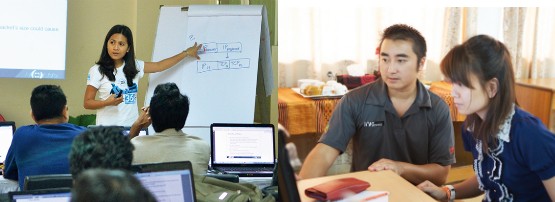
In February 2016, the APNIC EC made an important decision for the future of APNIC’s work on “Internet Development” in the Asia Pacific region. The decision was to establish the “APNIC Foundation” as a registered charity in Hong Kong which will raise funds, independently from APNIC membership contributions, to support and expand regional Internet development efforts into the future.
This is the first in a series of posts where I want to explain this decision, and how it follows naturally from the work of APNIC over many years.
APNIC’s focus on “Internet development” goes back to our founding Bylaws, which define our objectives as follows:
- to provide the service of allocating and registering Internet resources for the purpose of enabling communications via open system network protocols and to assist in the development and growth of the Internet in the Asia and Pacific Rim region;
- to assist the Asia and Pacific Rim Internet community in the development of procedures, mechanisms, and standards to efficiently allocate Internet resources as a service to the community as a whole;
- to provide educational opportunities to further Members’ technical and policy understanding of the industry;
- to develop public policies and public positions in the best interest of the Members and to seek legislative and regulatory consideration of issues of general benefit to the Members, where and when appropriate;
- to serve as the administrative, managerial and operations arm of APNIC Pty Ltd, and to transact all activities, functions and affairs on behalf, and in the name, of the corporation.
Here I’ve underscored the objectives which lie outside of the narrow technical role of APNIC as a Regional Internet address Registry (RIR) but which contribute additionally to developing the Internet in our region. These objectives have been well supported over the years by APNIC Members, who I believe have seen their success and their value – a value which is returned to the Membership in supporting their own work on building the Internet.
Since our inception, APNIC has pursued these Bylaw objectives within a modest budget, but a budget which has grown steadily over the years, and allowed more and more work to be done:
- In 1995, APNIC co-founded the APRICOT conference as a major meeting point and vehicle for professional education and networking within our community.
- In 1998, we started providing training, first in Internet resource management, then over time in other subjects including IPv6, Internet routing, and security.
- Since the late 1990s, we have made annual contributions to an evolving collaborative Internet R&D grants programme, now well-known as “ISIF”, the Information Society Innovation Fund.
- In 2000, we funded the first anycast DNS rootserver in our region, an instance of the ISC “F” root and the first globally-routed anycast node in the world.
- In 2003, we joined the ITU as a sector member and started collaborating on IPv6 activities with the regional office in Bangkok.
- Through the next decade, we continued to grow APNIC training – activities, curriculum, and delivery methods – as a core part of our activities, fulfilling a core expectation of our Members.
- In 2009, we were first admitted as a guest of APEC TEL, and successfully promoted the importance of IPv6 up to the Ministerial level.
- In 2015, we received our first support from the World Bank and the Japan International Cooperation Agency (JICA) in support of training and technical assistance activities.
- In 2015, we started initial trials of a Technical Assistance service, by which we can match up the technical challenges of individual network operators with the expertise required to address those specific issues.
- In 2016, we published The APNIC Development Program as a prospectus, which explains these activities, their justification and their importance for the healthy development of the Internet itself.
Over the life of APNIC, the growth of our “Development Program” has been substantial, but it has also been steady and gradual. It has continued under the guidance of the APNIC EC and of the APNIC Stakeholder Survey which has continued every two years. That survey has repeatedly confirmed the importance of training to the APNIC community and called for the additional activities we have adopted, such as online training, security engagement, technical assistance and closer liaison with governmental bodies.
It was also through the APNIC Survey that a new direction was initially highlighted: rather than relying solely on Member funds for supporting Internet development, APNIC should further expand activities through additional external funding. Over the years, we have found opportunities to do so with a number of training events, workshops, fellowships, and other APNIC activities. To fund these we have received financial support from the likes of Canada’s IDRC, the Swedish International Development Agency, the World Bank, ITU, and Japanese International Cooperation Agency, as well as from the Member community itself.
With this background, it was in August 2014 that the APNIC EC asked the Secretariat to start an investigation and review of options for a new additional funding mechanism, in the form of a Foundation:
“The EC invited the Director of Development to develop a proposal or a developmental funding foundation for further EC consideration, including consideration of developmental needs in the region, and the means and methods for fulfilling those needs, noting that APNIC is committed to providing no lesser level of developmental support than is the case today.”
In the EC meetings which followed, the APNIC Secretariat provided additional information which was considered and discussed before agreeing to proceed. For instance, a shortlist of locations was analyzed and reviewed before Hong Kong was selected as the place of incorporation. The specific reasons for this were that Hong Kong permits a fully non-resident Board of Directors, and also has no specific requirements for establishment of local office facilities (therefore minimising up-front costs).
As the APNIC EC reviewed each step in the development of the Foundation model, it also approved further work to continue over the course of the last year. Which brings me to the APNIC EC’s latest decision: to finally establish the APNIC Foundation. This is now underway and will be completed during 2016.
In my next post, I’ll describe the Foundation’s structure and how it is expected to function.
The views expressed by the authors of this blog are their own and do not necessarily reflect the views of APNIC. Please note a Code of Conduct applies to this blog.


Great